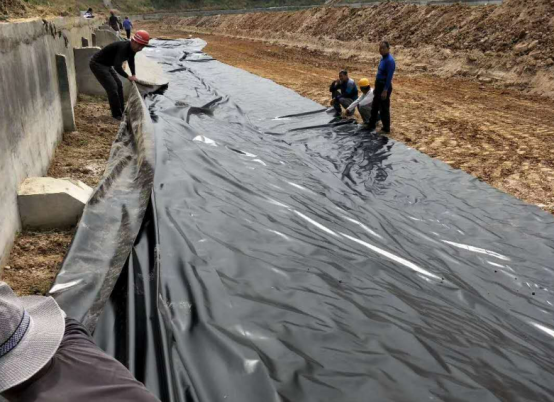Geomembrane Characteristics and Laying
Geomembrane to plastic film as impervious substrate, and non-woven composite geoimpervious material, new material geomembrane its impervious performance mainly depends on the impervious performance of plastic film. Impermeable plastic film at home and abroad, mainly polyvinyl chloride (PVC) and polyethylene (PE), EVA (ethylene/vinyl acetate copolymer), tunnel application and the design of the use of ECB (vinyl acetate modified asphalt blend geomembrane), they are a kind of polymer chemical flexible materials, small proportion, strong extensibility, high deformation ability. Corrosion resistance, low temperature resistance, good freezing resistance.
Geomembrane characteristics:
1. Complete width and thickness specifications.
2. Excellent environmental stress cracking resistance and chemical corrosion resistance.
3. Excellent chemical corrosion resistance.
4. It has a large temperature range and a long service life.
5. Used in landfill, tailings storage field, channel seepage prevention, dam seepage prevention and subway engineering
6, set anti-seepage and drainage in one, at the same time with isolation and reinforcement and other functions.
7, high composite strength, high peeling strength, high puncture resistance.
8, drainage capacity is strong, friction coefficient is large, line expansion coefficient is small.
9. Good aging resistance, wide range of environmental temperature and stable quality.
Process flow
The composite geomembrane impermeability of the dam in Zhoutou reservoir adopts the section cycle operation of digging, laying, tamping and protecting.
Base cleaning
The base surface must be cleaned up in accordance with the design requirements, which is the key to ensure the anti-seepage effect, especially for the pointed stone, roots and other debris to be completely removed, the base surface is not allowed to have local concave and convex phenomenon, clean up the base surface to use a tamper or tamper compaction, so that it is compact and smooth.
Composite laying
When spreading film, be sure to lay from bottom to top. Between the film and the film and the base surface to press tight, but should not pull the film too tight, generally a little loose, but can not leave bubbles at the bottom of the film. Because the geomembrane is relatively thin and very light, after paving, before the protective layer is not paved, it is easy to be blown by the wind, so the film area should not reach a large, the best side cover the protective layer of soil.According to the data provided by the manufacturer, the width of the composite geomemofilm is 1.0-1.9m. The project uses 1.9m width to reduce the material used in the joint. Joints have thermal bonding, adhesive, lap and other methods, this project design uses adhesive, joint width 50mm.If the puncture or tear of geomembrane is found, be sure to use three times the damaged area of geomembrane adhesive patch.
Protective visor
By geomembrane 10cm thick protective layer of soil material must be sifted, do not allow particle size of more than 6mm particles, otherwise easy to Pierce the geomembrane. The soil of the protective layer must be compacted by ramming, ensuring that the dry bulk density is above 1.5, and sampling inspection at any time. When backfilling protective layer and masonry block stone protective surface, be sure to put lightly, so as not to break the earth diaphragm. Under the block stone protection, should be filled with 100mm thick gravel or gravel cushion, to prevent the influence of water level changes, wind and waves and other factors washed soil material protection layer. The dry block stone is paved with artificial hanging line, the stone should be tightly embedded, the individual weight of the surface block stone should be greater than 48kg, and all the voids are filled with small block stone.
Peripheral processing
The requirements of peripheral connection treatment are to connect the composite geomembrane with the surrounding soil closely, block the seepage inlet, truncate the lateral leakage path, prevent seepage water from entering the bottom surface of the geomembrane, form bubbles, and burst the geomembrane when the water level of the reservoir drops. Therefore, the surrounding boundary must be cut water trough, and the geomembrane buried in the trough
Construction method
Geomembrane in the process of transportation do not drag, hard pull, avoid sharp stab.From the bottom to the high extension, do not pull too tight, should leave a 1.50% margin for local subsidence stretching. Taking into account the actual situation of the project, the slope is laid from top to bottom. Adjacent two longitudinal joints should not be in a horizontal line, should be staggered more than 1m; The longitudinal joint should be more than 1.50m away from the dam foot and bend foot, and should be located on the plane; First slope bottom; When the slope is laid, the direction of the film should be basically parallel to the maximum slope line.
lay
Before laying the geomembrane, the corresponding acceptance certificate of the civil engineering shall be issued. Before cutting the geomembrane, the relevant dimensions should be accurately measured and then cut according to the actual situation. Generally, it is not appropriate to cut the geomembrane according to the size shown. It should be numbered one by one and recorded in detail on the special form. When laying geomembrane should strive to minimum weld, under the premise of ensuring quality, try to save raw materials. It is also easy to guarantee the quality. The lap width of the joint between the film and the film is generally not less than 10cm, usually so that the weld alignment direction is parallel to the maximum slope, that is, along the slope direction. Usually in the corner and deformed section, should be as short as possible seam length. Except for special requirements, weld seams should not be installed within 1.5 meters from the top slope or stress concentration area on slopes greater than 1:6. In the laying of geomemofilm, artificial folds should be avoided. When the temperature is low, it should be tightened and paved as far as possible. After the completion of the geomembrane laying, should try to reduce the walking on the membrane surface, moving tools, where can cause harm to the impervious membrane objects, should not be placed on the membrane or carried on the membrane walking, so as to avoid accidental damage to the membrane.




